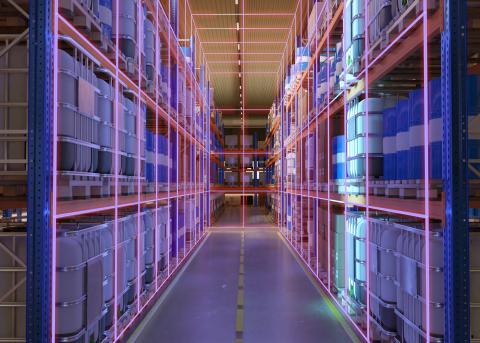INFORMATIE
Volg hier de laatste trends in de logistieke sector en
ontwikkelingen in logistieke software

Solutions
Type

Hoe Zeebrugge Food Logistics het maximale haalt uit Boltrics 3PL WMS
In een sector waar snelheid, nauwkeurigheid en flexibiliteit rechtstreeks invloed hebben op klanttevredenheid en concurrentiekracht, kunnen logistieke dienstverleners zich geen compromissen veroorloven. Een betrouwbaar en schaalbaar systeem is dan ook geen luxe, maar een strategische noodzaak. Zeebrugge Food Logistics (ZFL) laat zien hoe een moderne logistieke speler zijn operationele slagkracht vergroot door te investeren in slimme, toekomstgerichte software. Het resultaat? Een organisatie die klaar is voor de uitdagingen van vandaag én de groei van morgen.
Lees meer
Integraties: de onzichtbare kracht achter een soepele logistieke operatie
Systemen die niet met elkaar praten? Dat is vragen om vertraging, fouten en frustratie. In de logistiek – waar elke seconde telt – is slim koppelen daarom essentieel.
Onze partner Boltrics laat zien hoe integraties binnen uw Warehouse Management Systeem (WMS) het verschil maken tussen achter de feiten aanlopen en vooroplopen in de keten. Van foutloze communicatie met klanten en retailers tot volledig geautomatiseerde processen op de werkvloer – integraties zijn de lijm die alles samenbrengt. Lees de bijdrage van Wouter Toonen, Senior Integration Consultant bij Boltrics, en ontdek hoe u met de juiste koppelingen tijd wint, fouten voorkomt en uw operatie klaarstoomt voor de toekomst.
Lees meer
Transport en Logistics 2025: drie dagen vol innovatie, inspiratie en connectie
Om de twee jaar brengt Transport & Logistics Antwerpen de volledige logistieke sector samen – en ook dit jaar was dat niet anders. Van 14 tot 16 oktober 2025 stond Expo Antwerpen volledig in het teken van vooruitgang, samenwerking en digitalisering. Herbeleef het event: bekijk de aftermovie!
Lees meer
Nieuw: Flexibel updatebeleid - kies zelf het juiste moment
Als logistiek dienstverlener wilt u profiteren van de nieuwste technologie, zonder dat updates uw processen verstoren. Met onze nieuwe updatecyclus heeft ú de controle. Vanaf nu bepaalt u zelf het moment van updaten, binnen een flexibel venster van 2 tot 8 weken. Zo blijft u altijd up-to-date, precies wanneer het u uitkomt.
In deze blog leest u wat er verandert en hoe u hiervan profiteert.
Lees meer
3PL facturatie en contractbeheer vereenvoudigd
Het beheren van facturatie en contracten binnen de 3PL-sector is vaak complex en tijdrovend. Klantspecifieke afspraken, opslag- en servicekosten, pallet- en locatievergoedingen, wachttijden, toeslagen, tariefstructuren en kostentoewijzingen maken het lastig om het overzicht te bewaren en de controle te behouden.
Daar biedt Boltrics 3PL dé oplossing. Wilt u weten hoe?

Vergroot uw facturatiemogelijkeden met bewaarloon per locatie
Ontdek hoe deze functionaliteit je facturatie optimaliseert op basis van de werkelijke bezetting van de locaties, waardoor je jouw logistieke activiteiten flexibel en nauwkeurig kunt beheren.
Lees meer
Welkom in ons nieuwe kantoor
Een nieuw kantoor, frisse energie en een bezoekje aan ieders bureau!
Bekijk de video en neem een kijkje achter de schermen van onze nieuwe werkplek!
Lees meer
Ontdek de toekomst van de logistiek met ELEVATE!
Bent u actief in de logistieke sector en benieuwd naar de nieuwste technologische ontwikkelingen? Dan mag u SIL2025 in Barcelona niet missen. Dit toonaangevende internationale evenement brengt professionals, innovatie en expertise samen op één plek. Ook ELEVATE is van de partij – en we kijken ernaar uit u daar te ontmoeten.
Lees meer
Les Rendez-vous 2025 Strasbourg
Van 3 tot 5 juni 2025 komen de spelers uit de temperatuurgecontroleerde logistiek samen in Straatsburg voor #Rendezvous2025, het toonaangevende evenement georganiseerd door La Chaîne Logistique du Froid.
Dit jaar neemt ELEVATE France trots deel als officiële partner en sponsor, samen met professionals uit de sector. Drie dagen vol uitwisseling, innovatie en ontmoetingen om samen technologische oplossingen voor de koelketenlogistiek vooruit te helpen.
Ontdek onze aanwezigheid op het evenement, de modules die we in de kijker zetten en hoe u een afspraak met ons team ter plaatse kunt inplannen.
Lees meer
Webinar: Grijp kansen met een gestroomlijnd e-fulfillmentproces
In de snelgroeiende wereld van e-commerce is een efficiënt e-fulfillmentproces essentieel om je klanten tevreden te houden en kansen te grijpen.
Tijdens dit webinar ontdek je hoe je jouw processen kunt optimaliseren, kosten kunt besparen en je concurrentiepositie versterkt.
Laat je inspireren en zet de volgende stap naar een gestroomlijnde, toekomstbestendige logistieke operatie!

Van Moer Logistics tilt hun logistiek naar een hoger niveau met Optioryx en ELEVATE
Minder lucht, meer efficiëntie!
Slimmere verpakking, betere transportefficiëntie — dat was de uitdaging waar Van Moer Logistics samen met Optioryx en ELEVATE zijn schouders onder zette. In het kader van een VLAIO-project werd een innovatief traject opgezet om verpakkings- en transportprocessen aanzienlijk te optimaliseren. En met resultaat!
Lees meer
Webinar: Stroomlijn uw logistieke processen
Steeds kortere leveringstermijnen, toenemende eisen rondom productveiligheid en een aanhoudend tekort aan arbeidskrachten. Een kleine greep uit de uitdagingen waarmee u momenteel als logistiek dienstverlener mee wordt geconfronteerd. En dan hebben we het nog niet eens over de vergaande wensen van klanten.
Hoe kunt u aan alle verwachtingen voldoen zónder uw collega’s daarvoor met extra werk te hoeven belasten? En wat zijn de slimme trucjes om meer grip te krijgen op uw processen?
Bekijk het webinar nu!

Herken en verwerk inkomende documenten automatisch in uw logistieke software
De opkomst van kunstmatige intelligentie (AI) is niet meer te stoppen. Waar het praktische nut van AI een paar jaar geleden nog onzeker was, worden er inmiddels complete teksten geschreven met tools als ChatGPT. Maar AI gaat verder dan tekstgeneratie—ook in uw logistieke processen biedt het grote voordelen. Niet door teksten te schrijven, maar door ze te herkennen.
Lees meer
Het einde van Basic Authenticatie in SMTP voor Business Central: wat moet u weten?
Met de snelle vooruitgang van cloudtechnologie en een groeiende focus op beveiliging, past Microsoft zijn authenticatiemethoden ingrijpend aan. Een van de belangrijkste veranderingen is de uitfasering van basisverificatie in Microsoft SMTP voor Exchange Online, die vanaf september 2025 van kracht wordt. Dit heeft directe gevolgen voor gebruikers van Dynamics 365 Business Central die SMTP gebruiken voor het verzenden van e-mails via Exchange Online. In deze blog bespreken we de impact van deze wijziging, de reden achter Microsofts beslissing en hoe u zich hierop kunt voorbereiden.
Lees meer
Optimaliseer uw voorraadbeheer met dagboeken in 3PL Dynamics
Een correct en efficiënt voorraadbeheer is essentieel voor logistiek dienstverleners. Fouten in voorraadregistratie kunnen leiden tot vertragingen, onnodige kosten en zelfs klantontevredenheid. Daarom spelen dagboeken een cruciale rol in het bijhouden van voorraadmutaties. Ze bieden een gedetailleerd overzicht van alle transacties in het magazijn en helpen bij het opsporen en corrigeren van fouten.
Maar hoe werkt zo’n dagboek precies? Welke soorten dagboeken bestaan er? En hoe kunnen ze bijdragen aan een efficiënter voorraadbeheer? In deze blog geven we een overzicht van hoe u een dagboek aanmaakt en gebruikt om uw voorraadprocessen te optimaliseren.
Lees meer
AI-functionaliteiten standaard beschikbaar in uw logistieke software
Artificiële Intelligentie, ongetwijfeld dé trend van het afgelopen jaar. Maar het dreigt steeds meer een modewoord te worden – een term zonder echte inhoud. Iedereen praat erover, en elke softwareleverancier doet er iets mee.
Benieuwd hoe AI uw dagelijkse werkzaamheden kan transformeren? Lees verder en ontdek de mogelijkheden!
Lees meer
Het geheim achter het snelste support ticket ooit
Wanneer er onverwachts een probleem optreedt in uw systeem, is het essentieel om snel en effectief een supportticket aan te maken. U wilt de situatie helder beschrijven zonder onnodig veel tijd kwijt te zijn aan het verzamelen van bewijsstukken zoals screenshots, call stacks en gedetailleerde stappenplannen. Helaas is dit proces vaak tijdrovend en omslachtig – zeker wanneer de druk al hoog is en een foutmelding op het slechtst mogelijke moment opduikt.
Hoe kunt u dit proces vereenvoudigen en toch een volledig en duidelijk supportticket indienen?
Lees meer
Logistiek in beweging: de 3 hoofdthema's voor 2025
We staan aan de start van 2025. En zoals u van ons gewend bent bereiden we u voor op de belangrijkste trends. Kan uw logistieke operatie de druk op duurzaamheid aan? Of gaat uw positie in de supply chain veranderen? Blijf vooroplopen in 2025. We hebben de 3 belangrijkste trends voor u op een rij gezet.
Lees meer
How to: orderinvoer via het webportaal flexibel configureren
Een klantportaal is een krachtige tool om uw klanten direct orders aan te laten maken in uw softwaresysteem. Voorheen realiseerde we dit via het App Platform. Maar nu brengen we deze orderinvoerfunctionaliteit direct naar het webportaal met Web Portal Forms. Eerder introduceerden we de nieuwe orderinvoerfunctionaliteit via het webportaal al. Nu gaan we een stap verder en leggen we u stap voor stap uit hoe u webportaal formulieren zelf opbouwt.
Lees meer
De top 4 uitdagingen in Cold Logistics en hoe u ze aanpakt
De koel-vriesmarkt kampt met arbeidstekorten en druk op IT-capaciteiten, wat groei belemmert en SLA’s beïnvloedt. Dit artikel biedt oplossingen zoals automatisering, cloudtechnologie en branchespecifieke software om resourceproblemen aan te pakken. Ook belichten we hoe cybersecurity, AI en integraties bedrijven veerkrachtiger en schaalbaarder maken.
Lees meer